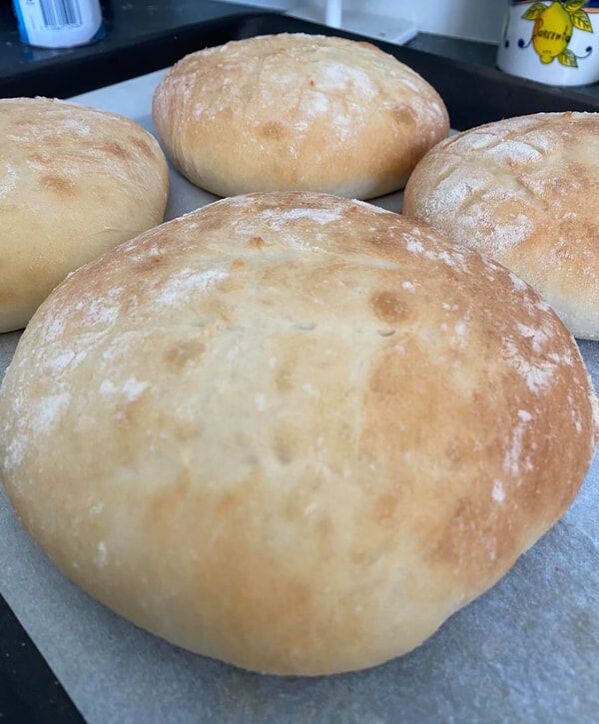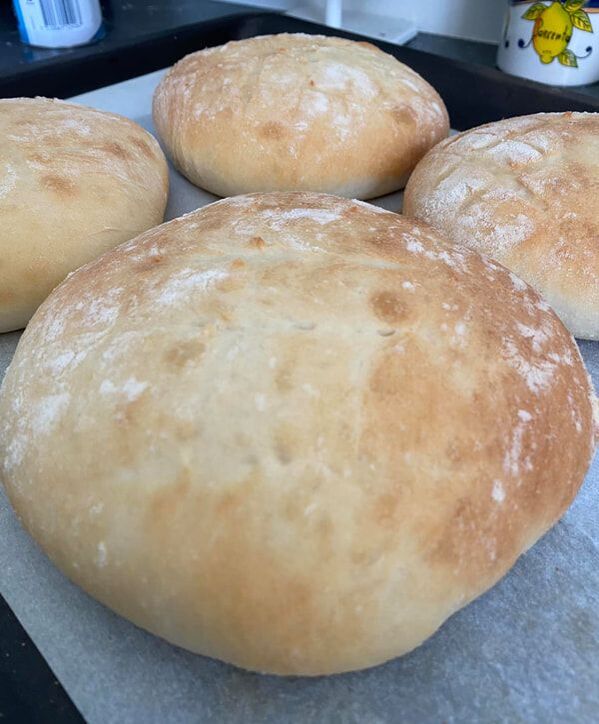Croatian Flatbread Lepinje
When you want to make cevapi for dinner, you have to make the perfect bread to go with it and that is lepinje.
These Lepinje are so good, they are light and fluffy, yet strong enough to hold the cevapi and sides together in sandwiches. These are so much better than store bought similar breads.
They take a little effort, nothing too strenuous, time does most of the work, but they are absolutely worth the effort.
Now although they are served traditionally with cevape, they are really good sandwich breads for any filling.
Traditionally cooked in a wood fired furnace, these are made in a hot oven and the results will not disappoint.
I prefer to make this with a free standing mixer as I don't have to add too much flour this way. If making it by hand kneading, only add enough flour where it is no longer too sticky.
These flatbreads are light, fluffy and delicious, you need to give these a go.
These Lepinje are so good, they are light and fluffy, yet strong enough to hold the cevapi and sides together in sandwiches. These are so much better than store bought similar breads.
They take a little effort, nothing too strenuous, time does most of the work, but they are absolutely worth the effort.
Now although they are served traditionally with cevape, they are really good sandwich breads for any filling.
Traditionally cooked in a wood fired furnace, these are made in a hot oven and the results will not disappoint.
I prefer to make this with a free standing mixer as I don't have to add too much flour this way. If making it by hand kneading, only add enough flour where it is no longer too sticky.
These flatbreads are light, fluffy and delicious, you need to give these a go.
Recipe
Recipe adapted from Andrea Pisac's cookbook Croatian Classics
Makes 4
500g plain flour, plus more for kneading and shaping
375ml warm water
7g dry yeast
4 tablespoons sunflower oil
1 teaspoon sugar
1 teaspoon salt
Makes 4
500g plain flour, plus more for kneading and shaping
375ml warm water
7g dry yeast
4 tablespoons sunflower oil
1 teaspoon sugar
1 teaspoon salt
Make the yeast starter: In a bowl add the yeast, sugar, half of the water and 1 tablespoon of the flour from the overall amount. Leave the mixture to stand for about 20 minutes, until it turns bubbly and doubles in volume.
In a large bowl of a free standing mixer add in the flour and whisk in the salt. Add your yeast starter to the flour. Pour in the rest of the water and 2 tablespoons of the oil. Bring the dough together with a wooden spoon first. Then switch to you mixer, using a dough hook, and work the dough for 5-6 minutes on medium speed.
Cover with a clean tea towel and leave it to stand in a warm place for about 1 hour, until it doubles in size.
Cover with a clean tea towel and leave it to stand in a warm place for about 1 hour, until it doubles in size.
When the dough has risen, deflate it by pushing your fingers in. Pour in the remaining 2 tablespoons of oil and work the oil into the dough by kneading it inside the bowl.
Turn the dough out on a well floured surface. Shape it into a log, then divide the log into four equal dough balls.
Knead the dough ball by going around and folding the outer side of the dough over itself and towards the centre.
Line a baking tray with baking paper. Gently turn the dough over and place it on your prepared tray seam side down, spacing them out evenly so none are touching.
Sprinkle with a pinch of flour and leave to stand for 20 minutes.
Preheat the oven to 250C/230C fan forced.
Pat the dough flat with your hands and carve shallow lattice shapes with a knife into each roll. Leave them to stand 10 minutes more.
Bake for 10-11 minutes, until the flatbreads rise and turn just slightly golden.
Turn the dough out on a well floured surface. Shape it into a log, then divide the log into four equal dough balls.
Knead the dough ball by going around and folding the outer side of the dough over itself and towards the centre.
Line a baking tray with baking paper. Gently turn the dough over and place it on your prepared tray seam side down, spacing them out evenly so none are touching.
Sprinkle with a pinch of flour and leave to stand for 20 minutes.
Preheat the oven to 250C/230C fan forced.
Pat the dough flat with your hands and carve shallow lattice shapes with a knife into each roll. Leave them to stand 10 minutes more.
Bake for 10-11 minutes, until the flatbreads rise and turn just slightly golden.
Enjoy!

